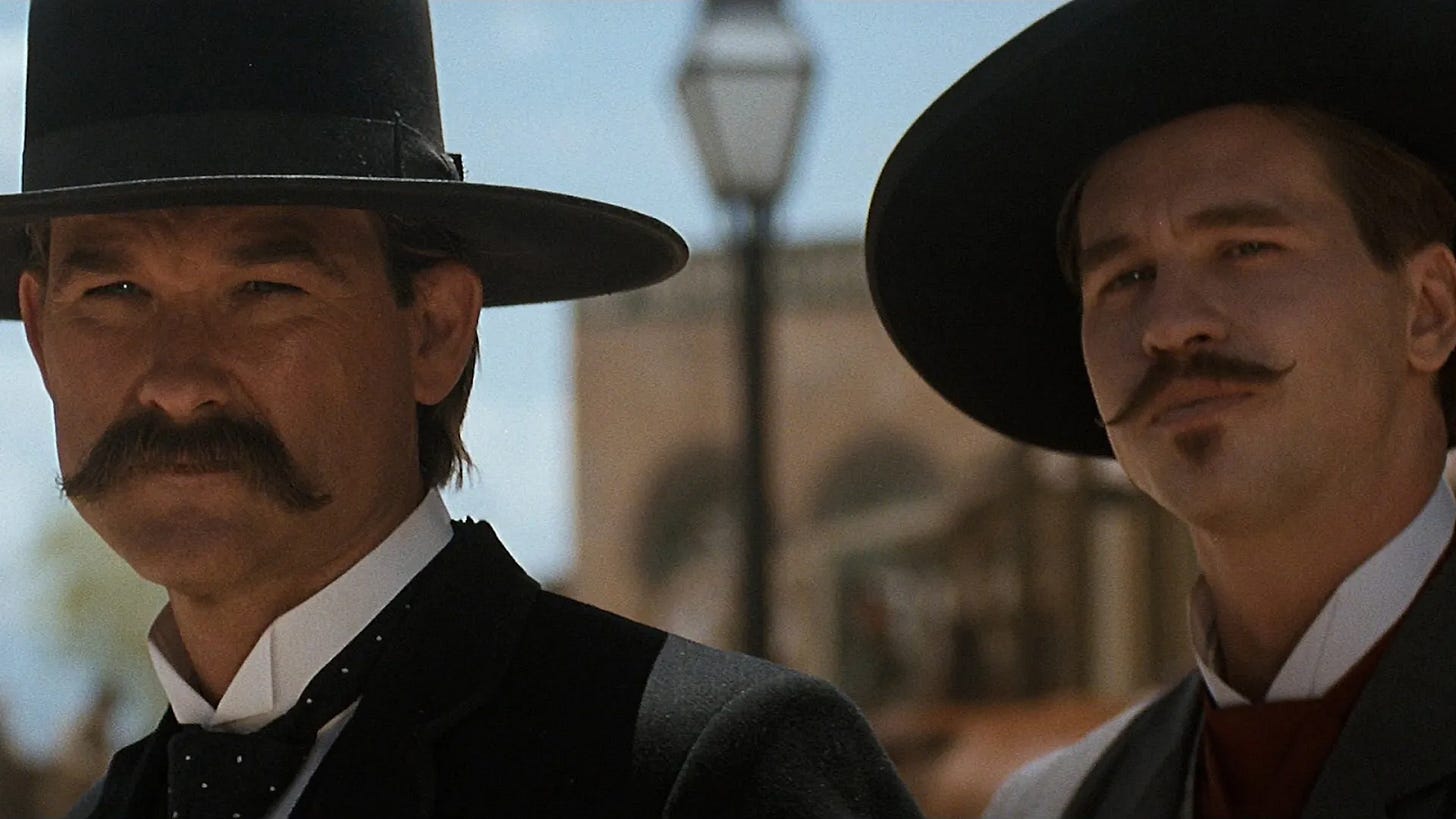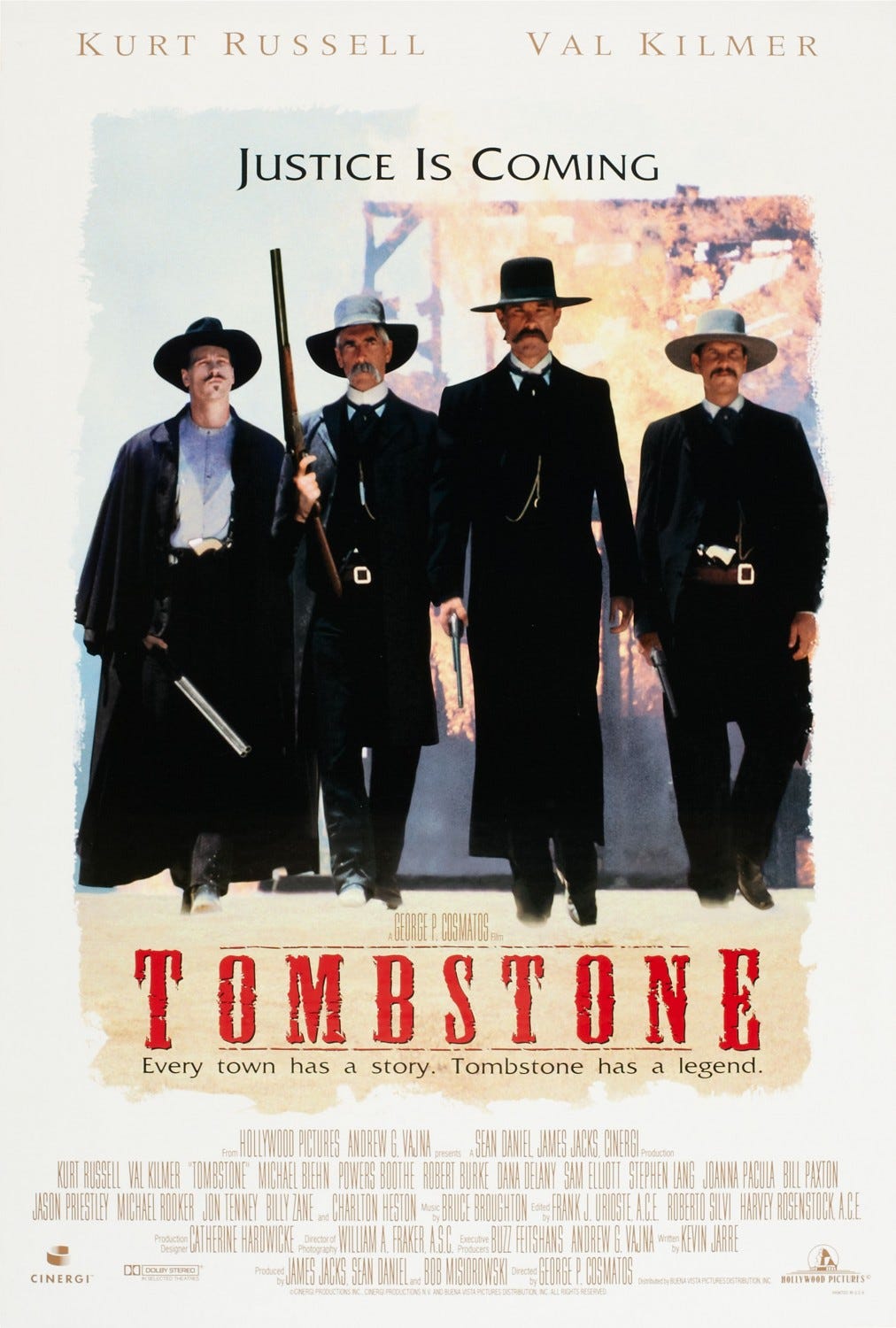Today’s issue of Dust On The VCR is a subscriber request! This cable TV classic was selected by my dear friend Jessica McCoy. Jessica and I met through our current employer, but it wasn’t long before she became a true friend rather than just a “work friend,” in part because we chat often about non-work things like TV and movies (don’t tell our bosses). Also, she’s a Clemson grad and I’m a Louisville grad, which means we really should hate each other, but she’s pretty hard to hate. Tombstone is one of her favorite movies, so I hope I didn’t ruin it for her by putting a bunch of weird and unnecessary labels on it, such as the one in today’s headline. (Maybe it’ll make her like it even more! Who’s to say?) Anyway. Want to request a film for a future issue? Subscribe to the paid version!
Reader, do you ever become unstuck in time while watching a film?
Stop me if I’ve written about this one before, but I recently read Chuck Klosterman’s latest book, The Nineties, which is all about that beloved decade that happened 30 years ago even though we like to pretend it was only 10 years ago. It’s a fascinating cultural examination of an era that I lived through but only remember bits and pieces of—memories through the eyes of a child/preteen at that.
One thing that stuck with me was Klosterman’s perspective on how we define the parameters of a decade. Mathematically speaking, the 90s began on January 1, 1990, but like Bono once said, nothing changes on New Year’s Day.* There wasn’t really a widespread shift in pop culture until nearly 21 months into the decade, when Nirvana’s Nevermind was released. Likewise, Klosterman pinpoints the “end of the 90s” almost exactly 10 years later when 9/11 happened.
While linear time is precise, cultural time can be rather fluid. With that in mind, maybe my recent rewatch of Tombstone isn’t all that strange. Because I kept thinking about how much it looks, feels, and especially moves like an 80s action movie.
The obvious place to start is with the creative team. Tombstone was written (and supposed to be directed) by Kevin Jarre, whose career began in earnest with an essential piece of 80s action junk: Rambo: First Blood Part II, which he shaped the story for before Sylvester Stallone and James Cameron (yes, that James Cameron) wrote the screenplay. He also wrote Navy Seals, which was released during the summer of 1990 and thus still counts as an 80s film by the aforementioned cultural standards.
Tombstone was meant to be Jarre’s first directorial credit, but he got overwhelmed by the gig, ultimately falling so far behind schedule that he was fired a month into the shoot. They replaced him with George P. Cosmatos, who had not only collaborated with Jarre on Rambo but also directed Cobra, another essential piece of the 80s action canon.
However! There are some who contend that Cosmatos was merely a “ghost director” and that Tombstone star Kurt Russell deserves the credit—including Russell himself.** Whatever the case may be, Russell surely had an influence over the production. And he was no stranger to 80s action films himself, having been the tough guy leading man in a trio of John Carpenter genre films and topping that off with Tango & Cash in 1989.
But you don’t need to know anything about the pedigree behind the camera to see Tombstone for what it is.
Sure, it’s a Western, but it’s far more concerned with bloodshed and one-liners than sweeping vistas or settler life. And you can forget about any of the historical complexities of manifest destiny—you wouldn’t know Indigenous peoples existed if you took this film as a history lesson. It’s good guys vs. bad guys, both of which are established immediately and presented without any gray area to speak of; instead of black hats, the villains wear red bandanas.*** But it’s a fun ride that doesn’t require much brain power in the same way that most 80s action movies are.
Tombstone’s timing is even more interesting when you consider the state of the Western in the early 90s.
The golden-age Westerns of the 40s and 50s were the action films of their day, giving audiences clear-cut heroes to root for and plenty of peril. Then the revisionist Westerns became more prominent in the 60s, 70s, and 80s, undoing the oversimplified narratives and character profiles of their predecessors to present a complex, unglamorous view of the American West. This included many films still considered to be classics, from A Fistful of Dollars to Butch Cassidy and the Sundance Kid.
Just as the calendar turned to the 90s, a significant thing happened to the genre: For the first time since Cimarron in 1931, a Western—Dances With Wolves—won Best Picture at the Academy Awards. And then it happened again just two years later with Unforgiven. Both films happened to do quite well at the box office too; Dances With Wolves was the third-highest-grossing film of 1990, and Unforgiven landed in the top 15 of 1992, both turning a hefty profit against their modest budgets.
So you had two revisionist Westerns captivating the filmgoing public in the span of three years. With that in mind, Tombstone feels intentional. Jarre and his team began rolling cameras just a couple months after Clint Eastwood hoisted his Oscars. And they weren’t concerned with revisionism of any sort. They took that golden-age template and injected an 80s action aesthetic directly into its veins, pumping it up for the enjoyment of modern audiences.****
But sure enough, audiences weren’t in the mood for Tombstone. It was a modest success compared to its budget, but it wasn’t nearly as profitable or as well-received critically as Dances With Wolves or Unforgiven. Gene Siskel didn’t recommend the film, but Roger Ebert quite liked it, going on to say later on that it “never got the recognition it deserved.”
To that point, I think Tombstone is a more interesting cultural artifact than meets the eye. It’s not just an 80s action movie disguised as a 90s Western, it’s a cult classic disguised as a blockbuster. And it’s still a crowd-pleaser more than 30 years later, no matter what your huckleberry may be.
*That song was released in 1983, but it could easily be mistaken by modern audiences for 1978, right?
**Val Kilmer, Russell’s costar, didn’t go quite that far in a recent(ish) interview. But he nonetheless gives Russell the most credit for the film’s success because of his work behind the scenes.
***There’s also an incredibly high body count, considering that members of the villainous Cowboys clan keep showing up seemingly just to be murdered.
****As my director pal Ben Stark said recently when we were discussing Tombstone, the only thing that separates it from 1946’s My Darling Clementine (another saga about Wyatt Earp and Doc Holliday) is film grammar and violence.
Tombstone is now streaming on Hulu, Paramount+, and PlutoTV, and it is available to rent elsewhere.






“it’s a cult classic disguised as a blockbuster” is SUCH a great way to describe Tombstone. You nailed it. This one looms large in the watching history of a lot of my peers (and myself). It’s VERY easy to forget that it wasn’t big on release.
As for “My Darling Clementine”… imagine the same story, told from a humane perspective and shot with the eye of the most brilliant stills photographer. The Criterion DVD is at one of the local libraries (Mtn Brook) and is worth a watch.
I found your reframing of Tombstone so helpful. It has bugged me since I first saw and loved/groaned at Tombstone when it was released. Thinking of it as an 80’s action movie makes it much easier to comprehend, and, for me at least, to forgive its worst moments e.g when Wyatt and Doc shake hands at a full gallop (groan!!)